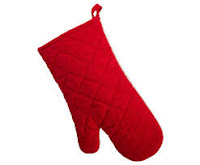KITCHEN LINEN
Aprons, kitchen towels, oven mitts and pot holders are essential for a well-functioning kitchen. They make it simple and safe to move food from the oven to the table, clean surface spills and are often pleasant to look at. Keeping your kitchen linen clean and organised reduces storage space and makes cleaning up after a meal a breeze! Wash linen after use (or at the end of the day), keeping enough of each type of linen in stock for several days of use and replace in the kitchen as required. Have too much kitchen linen? Consider donating to a charity store or animal shelter. Stained, ripped, frayed or worn out cloths become cleaning rags, and store seasonal/themed linen with holiday decorations.
USE: Hang kitchen towels up to dry between uses. Moisture, germs and odours will occur if towels and cloths are damp.
WASHING: Change your kitchen linen as required in the kitchen, then air dry in the laundry before putting the linen into the laundry basket. Wash kitchen linen with laundry powder/liquid (no softener!) on a hot setting, washing regularly (daily is recommended) to prevent odours and germs. Dry immediately after washing using a clothesline or dryer to prevent bacterial growth.
ODOURS: To reduce odours, soak towels and cloths in a bucket of warm water with a splash of white vinegar and a tablespoon of bicarbonate of soda (baking soda) for 15-20 minutes before washing.
WHITES: Add bleach to the washing load to brighten white kitchen linen.
Author: Megan Radaich
Image Credit: Megan Radaich
Publication: www.foodpreserving.org
Learn more with our Green Cleaning Guide
Acknowledgement
Kaya Wanjoo. Food Preserving kaditj kalyakoorl moondang-ak kaaradj midi boodjar-ak nyininy, yakka wer waabiny, Noongar moort. Ngala kaditj baalap kalyakoorl nidja boodjar wer kep kaaradjiny, baalap moorditj nidja yaakiny-ak wer moorditj moort wer kaditj Birdiya wer yeyi.
Hello and Welcome. Food Preserving acknowledges the Traditional Custodians of the land on which we live, work and play, the Nyoongar people. We recognise their connection to the land and local waterways, their resilience and commitment to community and pay our respect to Elders past and present.
Copyright © 2025 Megan Radaich. All rights reserved.
Except as permitted under the Australian Copyright Act of 1968, no other part of this website may be reproduced or utilised in any form by any means, electronic or mechanical, including photocopying, recording, or by any information storage and retrieval system without written permission from the author. Disclaimer
Except as permitted under the Australian Copyright Act of 1968, no other part of this website may be reproduced or utilised in any form by any means, electronic or mechanical, including photocopying, recording, or by any information storage and retrieval system without written permission from the author. Disclaimer














